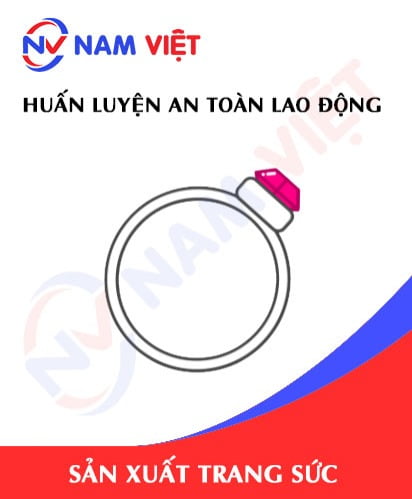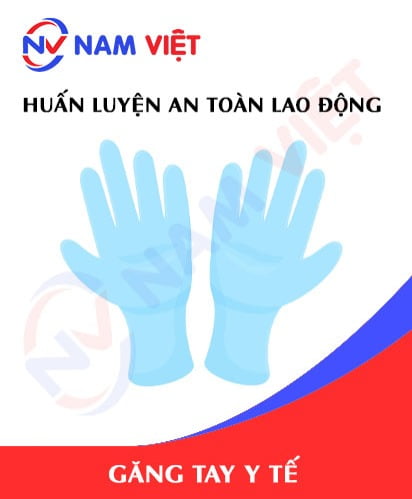Occupational safety training for jewelry manufacturing
99,000 ₫
Note: The above price is calculated per person, the price may vary depending on the number of trainees participating in the course and market fluctuations. For more accurate pricing support, please refer to the quotation or contact our consultants directly.
Occupational safety is an important issue in jewelry manufacturing factories and needs to be addressed promptly to ensure the health and safety of workers, and enhance the reputation of businesses. The Occupational Safety Training course is one of the effective solutions to raise awareness about how to prevent workplace accidents for workers participating in jewelry manufacturing.
Table of Contents
Toggle1. Overview of Jewelry
a. What is jewelry?
- Jewelry is an item made of precious materials like gold, silver, diamonds, pearls, and many other gemstones. Jewelry is used for beauty, expressing class, and is often worn on the body as necklaces, bracelets, rings, earrings, chains, hair jewelry, and many other forms. Jewelry can be produced by jewelers or purchased from jewelry stores.
- The manufacturing industry of exclusively precious metal jewelry in Vietnam is a relatively small industry, but it has been developing in recent years. The jewelry manufacturing businesses in Vietnam are mainly concentrated in major cities such as Ha Noi, Ho Chi Minh City, and Da Nang.
- The jewelry manufacturing industry in Vietnam has development potential due to the rich and diverse source of metal raw materials, along with lower production costs compared to other famous jewelry manufacturing countries like Italy or Thailand. In addition, this industry also faces many challenges such as difficulties in finding consumer markets, product quality not being guaranteed, and competition from other manufacturing countries.
- In recent years, the jewelry manufacturing industry in Vietnam has made great strides, with the export of jewelry to countries around the world such as the US, Europe, Australia, etc. However, this is still a relatively small industry in Vietnam.

b. Types of jewelry manufacturing machines
The common types of jewelry manufacturing machines include:
- Punching machine: A machine used to vacuum-punch holes on metal surfaces.
- Stamping machine: A machine used to stamp or press jewelry parts.
- Grinding machine: A machine used to grind and polish jewelry parts.
- Casting machine: A machine used to cast jewelry parts from different types of metals.
- Laser cutting machine: A machine used to cut metal parts with high precision.
- Laser engraving machine: A machine used to engrave patterns and text on jewelry parts.
- Lathe: A machine used to process metal by rotating its main spindle to remove excess parts.
Depending on the scale and scope of manufacturing, manufacturers can use one or more types of machines to manufacture jewelry.

c. Typical jewelry manufacturing businesses
Some typical jewelry manufacturing businesses in Vietnam include:
- PNJ (Phu Nhuan Jewelry): is one of the largest businesses in the jewelry industry in Vietnam with over 400 stores nationwide and jewelry products manufactured with modern technology.
- SJC (Sai Gon Jewelry Company): is the largest jewelry company in Ho Chi Minh City with many years of experience in manufacturing jewelry.
- DOJI: is a reputable business for gold jewelry in Vietnam, manufacturing and trading gold, silver, diamond, and pearl jewelry products.
- Pham Ngoc Jewelry: is one of the famous jewelry businesses in Vietnam with unique and creative designs.
- Kim Ngoc Jewelry: is a company specializing in manufacturing gold, silver, diamond, and pearl jewelry, while also providing services for polishing, grinding, and restoring jewelry.
d. Specific jobs in a jewelry manufacturing factory
Group 1
- Executive director, deputy executive director, department head in a jewelry manufacturing factory.
Group 2
- Safety officer: manages safety in the factory, designs safety procedures, supervises and urges employees to comply with safe work procedures.
Group 3
- Machining: After the design is complete, the product will be transferred to machining personnel. They will use tools such as cutting machines, lathes, and grinding machines to create the details and hardware of the product.
- Casting: Casting is the process of creating jewelry products from metal materials by pouring liquid into casting molds. After that, the product parts are machined and finished.
- Plating and coating: Jewelry products will be plated or coated to increase durability and reduce oxidation. Coating techniques include gold plating, silver plating, nickel plating, palladium plating,…
- Assembly: The details and hardware are assembled by hand or by machine. After that, the jewelry product is quality-checked before being put on the market.
- Packaging and transportation: The product is packaged, preserved, and prepared for transportation to points of sale or end customers.
Group 4
- Jobs in the office, service, sales, marketing.
- Production management, quality management, human resource management, material management, financial accounting management.
- Research and development of new products.
- Design: Design staff will create ideas and models for jewelry products. They use CAD (computer-aided design) software to create drawings and 3D models of the product.

e. Common types of jewelry on the market
Currently, there are many common types of jewelry on the market with diverse styles, materials, colors, and designs. Here are some common types of jewelry:
- Necklaces: This is one of the most popular types of jewelry used worldwide. Necklaces can be made of various materials, including gold, silver, gemstones, pearls, wood, and plastic.
- Rings: Rings are a type of jewelry worn on the finger. They can be made of gold, silver, gemstones, diamonds, and many other materials.
- Earrings: Earrings are a type of jewelry worn on the ears. They can be made of gold, silver, gemstones, pearls, and many other materials.
- Chains: Chains are a type of jewelry worn around the neck. They can be made of various materials, including gold, silver, gemstones, pearls, and wood.
- Bracelets: Bracelets are a type of jewelry worn around the wrist. They can be made of gold, silver, gemstones, diamonds, and many other materials.
- Lucky charms: This is a type of jewelry worn to bring luck and protection to the wearer. They can be made of various materials, including gemstones, wood, metal, and plastic.
- Bangles: Bangles are a type of jewelry worn around the wrist. They can be made of gold, silver, gemstones, diamonds, and many other materials.
In addition, there are many other types of jewelry such as hair accessories, hair clips, neck straps, ear piercings, key chains, anklets, and many other types of jewelry depending on each person’s personal preference and style.
2. Overview of occupational safety training for jewelry manufacturing
Within the scope of this article, we focus on addressing issues related to Group 3, because Group 3 is the group directly involved in the manufacturing process, bearing the highest risk of occupational safety. Learn more about other groups here
a. What is Group 3 occupational safety training?
- Occupational safety training for Group 3 consists of training sessions that equip workers with the awareness of how to prevent occupational accidents.
- The occupational safety training course will help workers identify and avoid dangers, and limit the risks of occupational accidents while working.
REGISTER FOR OCCUPATIONAL SAFETY TRAINING SERVICE
b. Training duration
Initial safety training duration
- The total training duration is at least 24 hours, including the examination time.
- 8 hours of theoretical study on the system of policies and laws on occupational safety and health
- 8 hours of theoretical study on basic knowledge of occupational safety and health
- 4 hours of theoretical study on specialized training content
- 2 hours of practical training on specialized training content
- 2 hours of theoretical examination at the end of the training course
The safety training center will distribute the time into several training sessions depending on the arrangement of study time for employees. But usually, there will be 6 training sessions, and the course will take place over 3 days, on the condition that the manufacturing business can arrange continuous study time.
Periodic safety training duration
- Before the occupational safety card expires, if the employee wants to have it re-issued, they must undergo a periodic occupational safety training course, with a periodic safety training duration of at least 50% of the initial safety training duration.
Explanation: the total periodic occupational safety training duration is at least 12 hours, including the examination time. After completing the periodic training course and passing the examination, the employee will have their occupational safety card re-issued or renewed.
c. Content of the training course
| No. | TRAINING CONTENT | TRAINING DURATION (HOURS) | |||
| Total | Of which | ||||
| Theory | Practice | Examination | |||
| I | System of policies and laws on occupational safety and health | 8 | 8 | 0 | 0 |
| 1 | Overview of the system of legal normative documents on occupational safety and health. | 6 | 6 | ||
| 2 | System of technical standards and regulations on occupational safety and health. | 1 | 1 | ||
| 3 | Specific regulations of state management agencies on occupational safety and health when building new, expanding, or renovating works, facilities for manufacturing, using, preserving, storing, and inspecting machinery, equipment, materials, and substances with strict requirements for occupational safety and health. | 1 | 1 | ||
| II | Basic knowledge of occupational safety and health | 8 | 8 | 0 | 0 |
| 1 | Basic knowledge of dangerous and harmful factors at the workplace. | 4 | 4 | ||
| 2 | Methods to improve working conditions. | 1 | 1 | ||
| 3 | Safety culture in manufacturing and business. | 1 | 1 | ||
| 4 | Rights and obligations of employers, employees; policies and regimes on occupational safety and health for employees; functions and duties of the occupational safety and health network. | 1 | 1 | ||
| 5 | Occupational safety and health regulations, signs, occupational safety and health instructions and the use of safety equipment, personal protective equipment; professional skills for first aid in occupational accidents, prevention of occupational diseases. | 1 | 1 | ||
| III | Specialized training content | 6 | 4 | 2 | 0 |
| Comprehensive knowledge of types of machinery, equipment, substances that generate dangerous and harmful factors; analysis, assessment, management of occupational safety and health risks, safe work procedures with machinery, equipment, and substances with strict requirements for occupational safety and health. | 6 | 4 | 2 | ||
| IV | Occupational safety training examination at the end of the training course | 2 | 2 | 0 | 0 |
| Total | 24 | 22 | 2 | ||
See more training content for the 6 groups
d. Occupational safety card
After completing the occupational safety training course and passing the exam, the employee will be issued an occupational safety card (in practice, it’s also called a Group 3 occupational safety certificate).
The Group 3 safety card will clearly show information such as: full name, date of birth, job, and specific working environment. It also includes the training duration, a red seal, and a signature confirming the completion of the training course.
According to the regulations for issuing safety cards specified in clause 2 Article 24 of Decree 44/2016/ND-CP, there are two cases:
- In the case where the employer and the employee have a labor contract, the employer must sign and stamp and affix a seal to the safety card for the trainee in Group 3 after they have completed the training course from the occupational safety training unit and passed the exam.
- In the case of freelance or seasonal workers who do not have a labor contract, the training unit must sign and stamp and affix a seal to the safety card for the employee after they have completed the training course from the occupational safety training unit and passed the exam.

3. Identifying hazards in jewelry manufacturing
Jewelry manufacturing also has some potential hazards, especially during the crafting, machining, and assembly of products. Some hazards in jewelry manufacturing can include:
- Metals such as nickel, cadmium, lead, mercury, and some other chemicals can be used to manufacture jewelry and can pose a health risk to workers during the manufacturing process.
- Equipment such as saws, grinding machines, drills, and hand tools are used to cut and machine metals and gemstones, which can pose a risk of cuts to workers.
- During the casting and machining of metals, workers can be exposed to heat, which poses a thermal hazard.
- During the manufacturing process, chemicals can be used to clean and purify metals and gemstones, which poses a risk of chemical accidents.
- Workers in the jewelry manufacturing industry can be exposed to X-rays and gamma rays from natural gemstones or from radiation sources during the manufacturing process.
- The job of manufacturing jewelry requires high precision, concentration, and patience. Workers may have to work in noisy, hot, or cold environments.
4. Common occupational accidents in jewelry manufacturing
Occupational accidents in the jewelry manufacturing industry often occur for the following reasons:
- Cuts, punctures, or impacts to hands, feet, or fingers while cutting, grinding, forging, or bending metal wires.
- Chemical poisoning: Chemical products used in the jewelry manufacturing process such as acids, detergents, solder, solvents, etc., can cause poisoning to workers if not used correctly or without adequate protection.
- Fire and explosion: The use of gas and electric welding in the jewelry manufacturing process can also cause fire and explosion if not performed correctly or if proper safety equipment is not used.
- High temperature: The process of casting and metal refining, and polishing jewelry sometimes requires very high temperatures, if workers do not wear adequate protective equipment such as masks, gloves, and specialized clothing, it can cause burns.
- Exposure to ultraviolet rays: Many types of ultraviolet rays are used in the jewelry manufacturing process to polish and machine details, however, long-term exposure to ultraviolet rays can cause eye damage and vision impairment for workers.
5. Safety measures when participating in jewelry manufacturing
Jewelry manufacturing is a job that requires meticulousness, sophistication, and care, therefore, ensuring occupational safety during the manufacturing process is very important. Here are some safety measures that need to be followed when participating in jewelry manufacturing:
- Workers must use full protective equipment such as safety glasses, masks, gloves, protective jackets, and safety shoes, to ensure the safety of their eyes, ears, mouth, hands, and feet.
- Workers need to be trained on how to use machinery, equipment, and other manufacturing tools correctly, ensuring safe and efficient operation.
- Ensure a clean and well-ventilated workplace, avoiding harmful chemicals and bacteria that are detrimental to health.
- Machinery, equipment, and other manufacturing tools need to be checked regularly to ensure they are working correctly, to avoid damage that can cause accidents to workers.
- Choose safe materials for users, avoiding materials that are harmful to health.
- Provide occupational safety training for employees on occupational safety regulations and manufacturing techniques, helping them improve their knowledge, skills, and awareness of occupational safety.
- Waste from the jewelry manufacturing process needs to be properly handled to avoid environmental pollution and ensure the safety of workers.
- Ensure there is a fire prevention and fighting plan and train workers on how to prevent and fight fires in case a fire occurs.
- Periodically organize work environment monitoring in factories and enterprises, collect and analyze factors harmful to workers, and from there, adjust to reduce the level of harm to prevent occupational diseases.

6. Benefits of occupational safety training for jewelry manufacturing
An Toan Nam Viet provides your business with the following great benefits after completing occupational safety training courses as regulated in Decree 44/2016/ND-CP on occupational safety and health for companies, factories, and businesses.
- Employees can identify the potential risks of occupational accidents and take preventive measures to avoid them.
- Your business can establish risk prevention measures in the manufacturing, operation, and maintenance processes.
- Minimize costs when occupational safety risks occur.
- Uninterrupted manufacturing will help increase labor productivity and product quality.
- Comply with occupational safety laws, avoiding legal risks.
- Create prestige and professionalism in all aspects, thereby enhancing the brand for your business.
Nam Viet’s training courses are a solution to prevent and combat external factors from affecting each individual so they can avoid dangers that can lead to injury or, more seriously, death.
REGISTER FOR OCCUPATIONAL SAFETY TRAINING SERVICE
7. Customer feedback after completing the occupational safety training course for jewelry manufacturing
An Toan Nam Viet has many years of experience in the mission of accompanying many businesses in Vietnam in general and in the southern provinces in particular. And that responsibility is something very precious to Nam Viet, which is why Nam Viet’s Occupational Safety Training is always focused on becoming more and more professional. And the motivation for An Toan Nam Viet to grow strong to this day comes from the positive feedback and suggestions from our partner businesses. Below are the feedback from our valued partners that we have served.
Bac Nam E&C Investment and Construction Joint Stock Company
“The first time I used the service at An Toan Nam Viet, I was very surprised by the enthusiastic 24/7 support from the team of consultants. The class organization was very fast and convenient for our company, thank you very much for Nam Viet’s service!”
Hoa Dat Construction and Trading Joint Stock Company
“Nam Viet’s service has helped us a lot in simplifying occupational safety and completing safety dossiers to serve our work process. The team of consultants is enthusiastic and timely in answering our questions. 5 stars for Nam Viet”
See more customer interviews after using An Toan Nam Viet’s service
8. An Toan Nam Viet’s Occupational Safety Training Capability
An Toan Nam Viet is a reputable and high-quality occupational safety training center in Vietnam today. With occupational safety training sessions continuously held at manufacturing workshops, factories, or construction sites throughout the country (63 provinces and cities in Vietnam).
REGISTER FOR OCCUPATIONAL SAFETY TRAINING SERVICE
Occupational safety training license
- An Toan Nam Viet has been inspected and certified by the Department of Labor Safety under the Ministry of Labor – Invalids and Social Affairs as eligible to operate occupational safety and health training. This further strengthens our occupational safety training capability.

Documents and lectures
- Before the occupational safety training materials are put into the occupational safety training courses, they have been reviewed and approved to ensure that the lectures are always correct in terms of knowledge and effective when applied.
- The teaching method of the lecturers is synchronized according to the teaching standards of An Toan Nam Viet, which is a method that experts in occupational safety and health training have researched and summarized during their teaching process to bring the highest knowledge acquisition efficiency to students.
Facilities
- Controlling the factors in the classroom that affect the training process will increase the teaching performance and the effectiveness of knowledge acquisition for students.
- Our training course support facilities always arrange spacious classrooms that meet standards for area, lighting, training equipment, etc.
9. Reputable and quality national safety training center
At An Toan Nam Viet, we always put our professional passion for occupational safety training as our top priority. For us, imparting knowledge to workers to help them protect themselves so they can have a safe journey on their path to earning a living is contributing to building the country.
To ensure effective training, we prepare carefully and meticulously even the smallest details. From preparing tools, equipment, teaching equipment to curriculum, materials, sound, and lighting.
Our occupational safety training lecturers are experts with many years of experience in the field. They even have research projects to identify dangers in all occupations and how to prevent them.
The lecturers’ lectures are distilled from real-world practice and conveyed in the most vivid and easy-to-imagine way to workers. These factors help workers feel comfortable during their study time and absorb our teaching knowledge well. Of course, the knowledge conveyed always closely follows Decree 44/2016/ND-CP.
From there, they grasp many measures to prevent dangers and how to protect themselves. At the same time, they also apply it in the most suitable way in their actual work.
Our safety training center is proud to be a reputable and professional provider of occupational safety training services with the following advantages:
- Competitive training costs but training quality is still guaranteed.
- Flexible training schedule to suit the manufacturing situation of the company.
- Fast and legally compliant procedures for issuing occupational safety training certificates.
- Lecturers are experienced professionals in the field.
- Classrooms are controlled for factors affecting the training process, which increases teaching performance and the effectiveness of knowledge acquisition for students.
- Lectures are compiled to be suitable for occupational safety work at businesses.
- An Toan Nam Viet works with dedication and professionalism to support customers accurately and quickly.

10. See more occupational safety training materials for jewelry manufacturing
- Occupational safety documents for jewelry manufacturing
- Set of occupational safety training materials
- Set of occupational safety training test questions
- Multiple-choice test for occupational safety in jewelry manufacturing
- Slides for occupational safety training lecture on jewelry manufacturing
1 review for Occupational safety training for jewelry manufacturing
No comments yet















namchinh.haiphong341
Dịch vụ huấn luyện an toàn lao động rất tốt nhé, giảng viên dạy rất sinh động dễ hiểu!